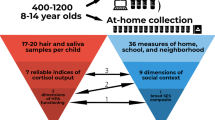Abstract
Purpose
Researchers benefit from controlling for individual differences that systematically account for variance in acute cortisol responses (e.g., sex). Similarly, some suggest that education could be used as a cortisol covariate because prior work found a negative relationship between education and the magnitude of acute cortisol responses in middle-aged adults. Nevertheless, education is seldom controlled for in tests of cortisol responses to acute stress, in part because the effect of education on acute cortisol responses has yet to be tested in a college sample. The present study therefore tested the relationship between education and cortisol responses to acute stress in college students.
Method
Participants (124 healthy undergraduate students) self-reported education level and were subjected to a stressful speech task. Salivary cortisol was collected 0, + 15, + 25, + 40, and + 55 min post-stressor onset. Participant also completed a battery of questionnaires assessing individual differences, day-to-day demands, and stress-related appraisals.
Results
Students in their fourth year of college education or above had significantly less curvilinear responses to the stress task relative to first-, second-, and third-year students.
Conclusion
The effect of education on cortisol responses previously found in middle-aged adults was replicated in college students. Future research may therefore benefit from controlling for education when analyzing acute cortisol responses in college samples.

Similar content being viewed by others
References
Kirschbaum C, Pirke K-M, Hellhammer DH. The “Trier Social Stress Test”: a tool for investigating psychobiological stress responses in a laboratory setting. Neuropsychobiology. 1993;28:76–81.
Dickerson SS, Kemeny ME. Acute stressors and cortisol responses: a theoretical integration and synthesis of laboratory research. Psychol Bull. 2004;130:355–91.
Luecken LJ, Gallo LC. Handbook of physiological research methods in health psychology. SAGE Publications; 2007.
Adler NE, Boyce T, Chesney MA, Cohen S, Folkman S, Kahn RL, et al. Socioeconomic status and health: the challenge of the gradient. Am Psychol. 1994;49:15–24.
Lupie SJ, King S, Meaney MJ, McEwen BS. Can poverty get under your skin? Basal cortisol levels and cognitive function in children from low and high socioeconomic status. Dev Psychopathol. 2001;13:653–76.
Sapolsky RM. The influence of social hierarchy on primate health. Science. 2005;308:648–52.
Knight EL, Mehta PH. Hierarchy stability moderates the effect of status on stress and performance in humans. Proc Natl Acad Sci. 2017;114:78–83.
Fiocco AJ, Joober R, Lupien SJ. Education modulates cortisol reactivity to the Trier Social Stress Test in middle-aged adults. Psychoneuroendocrinology. 2007;32:1158–63.
Adam EK, Kumari M. Assessing salivary cortisol in large-scale, epidemiological research. Psychoneuroendocrinology. 2009;34:1423–36.
Herbison CE, Henley D, Marsh J, Atkinson H, Newnham JP, Matthews SG, et al. Characterization and novel analyses of acute stress response patterns in a population-based cohort of young adults: influence of gender, smoking, and BMI. Stress. 2016;19:139–50.
Hansen AM, Garde AH, Persson R. Sources of biological and methodological variation in salivary cortisol and their impact on measurement among healthy adults: a review. Scand J Clin Lab Invest. 2008;68:448–58.
Gable SL, Reis HT, Elliot AJ. Behavioral activation and inhibition in everyday life. J Pers Soc Psychol. 2000;78:1135–49.
Bollen K, Lennox R. Conventional wisdom on measurement: a structural equation perspective. Psychol Bull. 1991;110:305–14.
Watson D, Clark LA, Tellegen A. Development and validation of brief measures of positive and negative affect: the PANAS scales. J Pers Soc Psychol. 1988;54:1063–70.
Cohen S, Kamarck T, Mermelstein R. A global measure of perceived stress. J Health Soc Behav. 1983;24:385–96.
Maslach C, Jackson SE. The measurement of experienced burnout. J Organ Behav. 1981;2:99–113.
Radloff LS. The use of the Center for Epidemiologic Studies Depression Scale in adolescents and young adults. J Youth Adolesc. 1991;20:149–66.
Spielberger CD, Gorsuch RL, Lushene RE. Manual for the State-Trait Anxiety Inventory. Consulting Psychologists Press; 1970.
Juth V, Dickerson SS, Zoccola PM, Lam S. Understanding the utility of emotional approach coping: evidence from a laboratory stressor and daily life. Anxiety Stress Coping. 2015;28:50–70.
Pascarella E, Terenzini P. How college affects students: a third decade of research (Vol. 2). Jossey-Bass; 2005.
Cohen AK, Syme SL. Education: a missed opportunity for public health intervention. Am J Public Health. 2013;103:997–1001.
Rubin M, Denson N, Kilpatrick S, Matthews KE, Stehlik T, Zyngier D. “I am working-class”: subjective self-definition as a missing measure of social class and socioeconomic status in higher education research. Educ Res. 2014;43:196–200.
Sewell WH, Hauser RM. Causes and consequences of higher education: models of the status attainment process. Am J Agric Econ. 1972;54:851–61.
Gruenewald TL, Kemeny ME, Aziz N, Fahey JL. Acute threat to the social self: shame, social self-esteem, and cortisol activity. Psychosom Med. 2004;66:915–24.
Gruenewald TL, Kemeny ME, Aziz N. Subjective social status moderates cortisol responses to social threat. Brain Behav Immun. 2006;20:410–9.
Funding
This work was supported by the National Science Foundation [grant number BCS-0720066] and University of California, Irvine Academic Senate Council on Research, Computing, and Library Resources (to the last author). The funding source had no involvement in the study design, collection, analysis and interpretation of data, the writing of the report, or the decision to submit the article for publication.
Author information
Authors and Affiliations
Corresponding author
Ethics declarations
Informed consent was obtained from all participants, and the Institutional Review Board of University of California, Irvine, approved all procedures.
Conflict of Interest
The authors declare that they have no conflicts of interest.
Rights and permissions
About this article
Cite this article
Manigault, A.W., Woody, A., Zoccola, P.M. et al. Education Is Associated with the Magnitude of Cortisol Responses to Psychosocial Stress in College Students. Int.J. Behav. Med. 25, 532–539 (2018). https://doi.org/10.1007/s12529-018-9727-y
Published:
Issue Date:
DOI: https://doi.org/10.1007/s12529-018-9727-y




